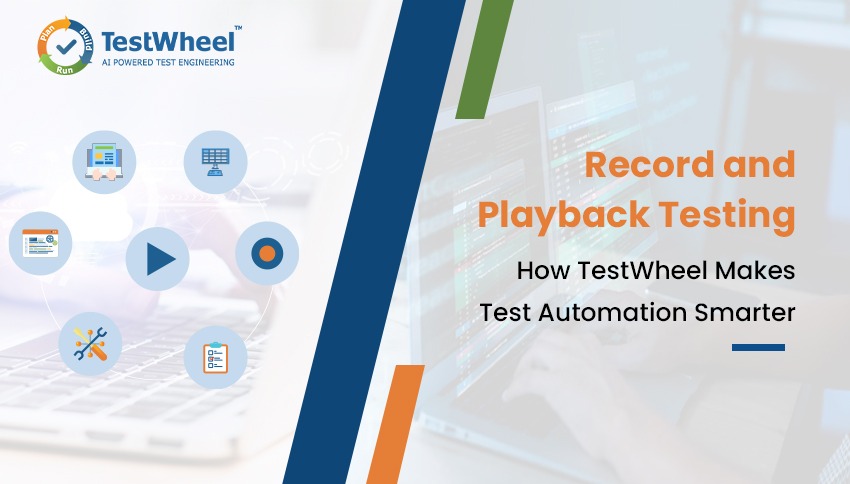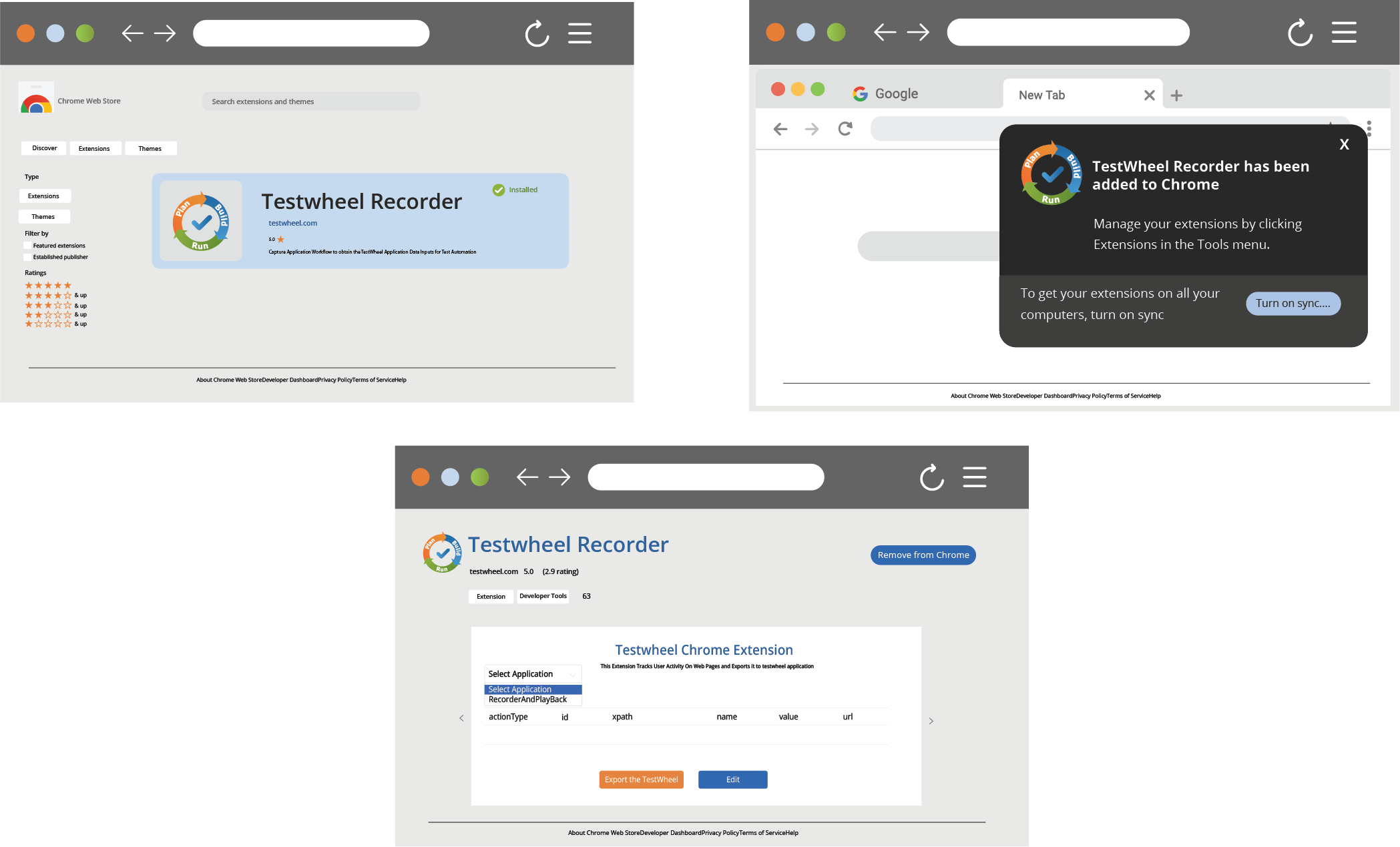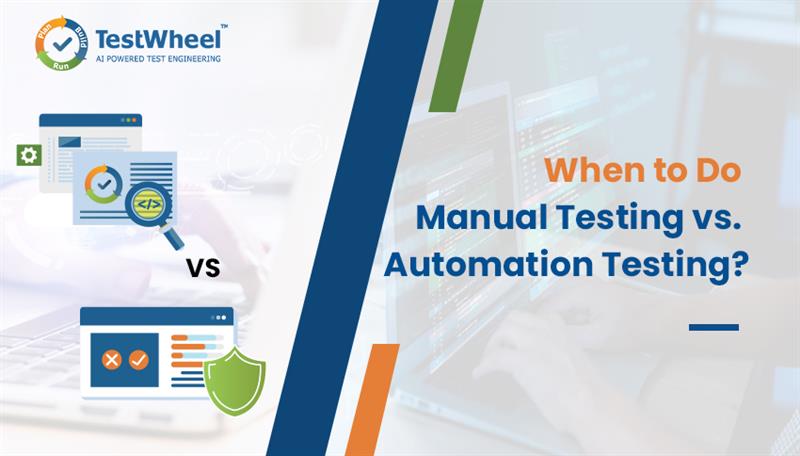- October 31, 2025

Test automation promises speed, accuracy, and freedom from human error. But in the real world, automation comes with brittle scripts, maintenance overhead, and a steep learning curve that requires serious technical know-how.
A solution to this is record and playback testing. Testers simply navigate to the UI elements/flows they want to test, hit “Record” while performing user actions and instantly have a reusable automated test.
QA teams no longer have to put up with coding marathons or fragile scripts breaking with every UI change. As this article will explain, this feature simplifies testing to a great extent. It also makes test creation accessible to non-technical stakeholders, making the process more democratic and collaborative.
The piece will also introduce you to TestWheel, and discuss how its record-and-playback feature optimizes the QA pipeline and can outshine tools like Selenium IDE for easier maintenance and smarter editing.
Table of Contents
Hidden Costs of Scripted Test Automation in Agile Teams
Traditional scripted automation can certainly be a productivity boost for most QA teams. However, implementing it, especially in the initial stages, can seem like an uphill battle. Script-based automation comes with a number of challenges:
High Technical Barrier
You cannot build test automation scripts without solid programming knowledge in Java, JavaScript, Python, and other languages. Testers without coding knowledge simply cannot contribute, which limits collaboration and slows down test automation efficiency.
Additionally, tests are often delayed since only a few skilled individuals can build them while the rest of the team only provides inputs.
Time-Consuming Test Creation
It takes hours, often days, to write code line by line. Even simple workflows require dozens of lines of code. Writing hundreds of test cases, normal in most projects, will take weeks: time that could be used to run more meaningful tests.
Fragile Scripts
Even the smallest tweaks to the UI (renaming an element ID, moving a button) can cause test scripts to fail. Engineers have to keep chasing false negatives and constantly rewriting scripts.
High Maintenance Cost
Applications evolve with every sprint, and automation scripts have to keep up. Again, engineers have to keep updating scripts as test suites grow in size. Test maintenance challenges trap them in an endless cycle of maintenance. More time, effort, and resources.
What Is Record and Playback Testing?
Record and playback testing is an approach to test automation. In it, QA checkers directly record user actions (clicking buttons, filling out forms, switching between screens) by performing them on the target web page and/or app. Then, the relevant tool can replay the recorded steps anytime that particular flow has to be tested, without having to perform the steps by hand.
How Record and Playback Tools Simplify Test Creation
Record-playback test automation greatly reduces the need for coding expertise, even for testing complex UI sequences. It opens up testing to more QA professionals, who can bring unique perspectives without having to pick up a whole new skill.
A few benefits of streamlined test creation via record and playback mechanisms would be:
- Natural test authoring in which testers just interact with an application from the POV of the real world, and record the process. No need to write any code; the record and playback testing tool converts the workflows into code.
- Instant script generation from recorded actions, which reduces the time needed for test creation, and allows teams to focus on managing test coverage instead of coding.
- Quick onboarding for new testers, as they can quickly start recording test steps and contributing to automation.
- Makes tests easier to review as record and playback testing tools display the test flow in a visual, step-by-step format. This simplifies bug reproducibility and debugging.
- Keeps tests consistent, as recorded steps are used repeatedly. No human testers are creating test steps every time, which reduces the impact of human error.
- Reusable steps eliminate duplication and save scripting time.
- Since testers do not need to be trained in a specific scripting language, the learning curve for new team members is quite flat. They can quickly start recording steps and running steps. Their only concern is the automation logic, not actual lines of code.
When to Use Record and Playback Testing (and When Not To)
Record and playback tests (at least in traditional formats) cannot replace all forms of automation. It works best for specific use cases, and not at all for others.
When Record and Playback Tests Work Best
- Smoke Testing: Verifies that the application is stable after a new build.
- Regression Testing: Checks that core workflows are unaffected by any new features and code changes.
- Rapid Prototyping: Building tests in parallel with actual development, in accordance with Agile principles for faster feedback.
- Onboarding New Testers: Helps new team members without technical expertise understand test flows and contribute to automation as soon as possible.
- Verifying Repetitive User Journeys: Automating common workflows like login, checkout, or form submits.
When Not to Rely on Just Record and Playback
- Complex Workflows: All tests that need the use of advanced logic, conditional paths, or data-driven scenarios.
- Large-Scale Test Suites: Test suites with dozens of test cases often exist without modularity if they are largely recorded. This quickly becomes unmanageable.
- Highly Dynamic UIs: Recorded tests fail when dealing with applications undergoing frequent design changes.
- Critical Business Flows: Recorded tests (unless customized closely) don’t offer reliability and depth of validation for complex features. In these cases, custom scripting or hybrid approaches work better.
Record playback test automation is best used as part of a broader strategy. Tools like TestWheel reduce maintenance overload by allowing step-level editing instead of forcing complete re-recordings.
Using Record Playback Test Automation: Best Practices
To unlock the full potential of record and playback testing, apply these best practices with intention. Here’s how to create successful automation and prevent fragile test suites:
Think of Test Recordings as a Starting Point
Recorded tests work quite well as the baseline for automation suites. But they don’t go too far in their raw, unrefined forms. Testers need to clean up, modularize, and optimize these tests. For example, convert repetitive login sequences into reusable components, rather than duplicating them across multiple tests.
Prioritize Recordings for Stable, Repeatable Flows
Don’t bother using record and playback for highly dynamic and frequently changing UIs. That usually makes the tests brittle. Instead, use it to validate:
- Core regression flows (e.g., checkout, login, search).
- Smoke tests after deployments.
- Validation of stable, business-critical paths.
Edit at the Step Level Instead of Rebuilding
As mentioned before, traditional record-and-playback tools require testers to re-record an entire flow for even the tiniest UI changes. But with certain tools like TestWheel, they can just edit the specific step that broke instead of the whole thing. This saves hours of rework and keeps suites lean. Just make granular edits part of your team’s maintenance workflow.
Combine Recordings with Assertions for Real Validation
A pure “happy-path” playback will rarely provide complete coverage of a feature by itself. Pair recorded tests with assertions to validate outcomes:
- Verify page titles, API responses, or database changes.
- Check error messages for invalid inputs.
- Validate that critical elements remain visible after actions.
Keep Test Suites Modular and Maintainable
Group tests logically, keep flows modular, and apply naming conventions. It is imperative to prevent duplication and prevent “test bloat,”. In the absence of this practice, teams will deal with painfully massive management obligations.
Regularly Update Recordings as the App Grows
Software evolves rapidly, and tests must keep pace. Set up a regular cadence in which testers review which recordings are still relevant. They can update steps after workflow changes, and retire outdated recordings that no longer reflect business value. This keeps the automation suite lean, accurate, and fast.
TestWheel vs Selenium IDE: Comparison
Selenium IDE is among the most well-known of script less testing tools. This record and playback testing tool lets QA engineers record user actions like clicks, text inputs, and navigation within a web app. These steps can then be replayed as automated steps. Given the popularity of the Selenium framework, the adoption of Selenium IDE is also quite wide.
However, despite its ease in creating tests, it comes with limitations in editing, maintainability, and scalability.
| Feature | Selenium IDE | TestWheel |
|---|---|---|
| Ease of Editing | Minor workflow changes require test rebuilds | Edit specific steps directly—no need to rebuild entire test |
| Maintenance Effort | High—scripts break with small UI updates | Lower—granular editing keeps tests stable |
| Flexibility | Browser-based, but less intuitive for scaling | Designed for broader test efficiency |
| Efficiency | Good for quick prototypes, not large suites | Streamlined for effective regression testing |
Traditional record-and-playback tools like Selenium IDE force testers to start from scratch whenever workflows change. With TestWheel, you simply open the test case and edit only the affected steps. This makes TestWheel record playback test automation far more practical in agile environments.
How TestWheel Simplifies Record and Playback Testing (Step by Step)
Here’s a quick look at how to record and run tests on TestWheel’s intuitive UI:

- Download and install the TestWheel recorder from the Chrome web store.
- Register or log into the TestWheel codeless automation testing platform.
- Create an application and click the recorder button.
- Navigate to the web application that you desire to generate the test script and perform interaction with the application.
- Once done with the required action export the test script to TestWheel. The exported test script is editable to make further changes if required.
- Trigger the Start button to run the test and validate the input actions in the test results.
It’s that easy. Just try it yourself by installing the TestWheel Recorder.
How TestWheel Addresses Common Problems with Record and Playback Testing
Common Drawbacks of Record-and-Playback Testing (Industry-Wide)
● Brittle tests with UI change: Small shifts in element locators or layout often break recorded flows, creating high maintenance overhead.
● Limited flexibility for complex scenarios: Recorded tests can struggle with data parameterization, conditional logic, and reusable components—reducing scalability.
● Maintenance overload at scale: As suites grow, re-recording or mass-updating flows becomes costly and slow.
● Shallow validations if not augmented: Some recorders historically lacked rich assertions or editing, leading to “happy-path only” checks unless additional work is added
1) “Pure playback” fragility → Hybrid framework + POM
● What TestWheel says: “TestWheel is not a record and playback script… it provides a hybrid framework on the cloud… based on the industry-standard Page Object model.
● Why this helps: POM and keyword/data-driven patterns generally reduce locator thrash and promote reusable steps—classic mitigations for brittle recorded flows.
2) “Recorder-only” limits → Recorder Exports to the Platform; Customize Assertions & Variables
- What TestWheel says (Chrome extension listing): You record interactions and export the acquired user-flow data directly to the TestWheel platform. You can customize test data by adding assertions and modifying variables before running tests. Chrome Web Store
- Why this helps: Being able to add assertions and adjust variables addresses the common critique that recorders generate shallow validations and fixed data only. (Many legacy tools didn’t let you meaningfully edit runs post-record e.g testRigor)
3) “Re-record when the app evolves” → Update Tests on the Platform
- What TestWheel says (Chrome extension listing): Run the test cases anytime and update it when the application evolves.” Chrome Web Store
Why this helps: Instead of re-recording from scratch each time the UI changes, TestWheel indicates you can update tests within the platform—reducing rework typical of strict playback tools. (Note: TestWheel’s own Recorder page clarifies that the Recorder itself has no playback; you capture and then manage/run on the platform.)
4) “Locked into what you recorded” → AI-Assisted Conversion From Existing Scripts to No-Code Templates
- What TestWheel says (Web Testing page): Upload your existing scripts and easily convert them into no-code templates using our AI chatbot… Say goodbye to brittle, flaky testing and time spent on script maintenance.
- Why this helps: Converting existing scripted assets into maintainable, no-code templates can improve reuse and reduce the need to rely exclusively on newly recorded flows.



